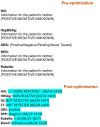Saving Time for Patient Care by Optimizing Physician Note Templates: A Pilot Study
- PMID: 35098206
- PMCID: PMC8792616
- DOI: 10.3389/fdgth.2021.772356
Saving Time for Patient Care by Optimizing Physician Note Templates: A Pilot Study
Abstract
Background: At times, electronic medical records (EMRs) have proven to be less than optimal, causing longer hours behind computers, shorter time with patients, suboptimal patient safety, provider dissatisfaction, and physician burnout. These concerning healthcare issues can be positively affected by optimizing EMR usability, which in turn would lead to substantial benefits to healthcare professionals such as increased healthcare professional productivity, efficiency, quality, and accuracy. Documentation issues, such as non-standardization of physician note templates and tedious, time-consuming notes in our mother-baby unit (MBU), were discussed during meetings with stakeholders in the MBU and our hospital's EMR analysts. Objective: The objective of this study was to assess physician note optimization on saving time for patient care and improving provider satisfaction. Methods: This quality improvement pilot investigation was conducted in our MBU where four note templates were optimized: History and Physical (H and P), Progress Note (PN), Discharge Summary (DCS), and Hand-Off List (HOL). Free text elements documented elsewhere in the EMR (e.g., delivery information, maternal data, lab result, etc.) were identified and replaced with dynamic links that automatically populate the note with these data. Discrete data pick lists replaced necessary elements that were previously free texts. The new note templates were given new names for ease of accessibility. Ten randomly chosen pediatric residents completed both the old and new note templates for the same control newborn encounter during a period of one year. Time spent and number of actions taken (clicks, keystrokes, transitions, and mouse-keyboard switches) to complete these notes were recorded. Surveys were sent to MBU providers regarding overall satisfaction with the new note templates. Results: The ten residents' average time saved was 23 min per infant. Reflecting this saved time on the number of infants admitted to our MBU between January 2016 and September, 2019 which was 9373 infants; resulted in 2.6 hours saved per day, knowing that every infant averages two days length of stay. The new note templates required 69 fewer actions taken than the old ones (H and P: 11, PN: 8, DCS: 18, HOL: 32). The provider surveys were consistent with improved provider satisfaction. Conclusion: Optimizing physician notes saved time for patient care and improved physician satisfaction.
Keywords: efficiency; improve documentation; optimizing physician note; provider satisfaction; time saving.
Copyright © 2022 Alissa, Hipp and Webb.
Conflict of interest statement
The authors declare that the research was conducted in the absence of any commercial or financial relationships that could be construed as a potential conflict of interest.
Figures





References
-
- CMS regulations and Guidance . (2018). Available online at: https://www.cms.gov/Regulations-and-Guidance/Legislation/EHRIncentivePro...
-
- Middleton B, Bloomrosen M, Dente MA, Hashmat B, Koppel R, Overhage JM, et al. . Enhancing patient safety and quality of care by improving the usability of electronic health record systems: recommendations from AMIA. J Am Med Inform Assoc. (2013) 20:e2–8. 10.1136/amiajnl-2012-001458 - DOI - PMC - PubMed
-
- Stead WW, Lin HS. Computational Technology for Effective Health Care: Immediate Steps and Strategic Directions. Washington (DC): National Academies Press (US). (2009). - PubMed
LinkOut - more resources
Full Text Sources
Miscellaneous

